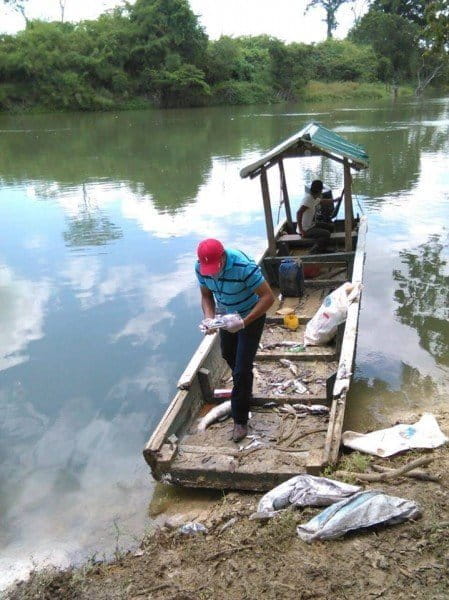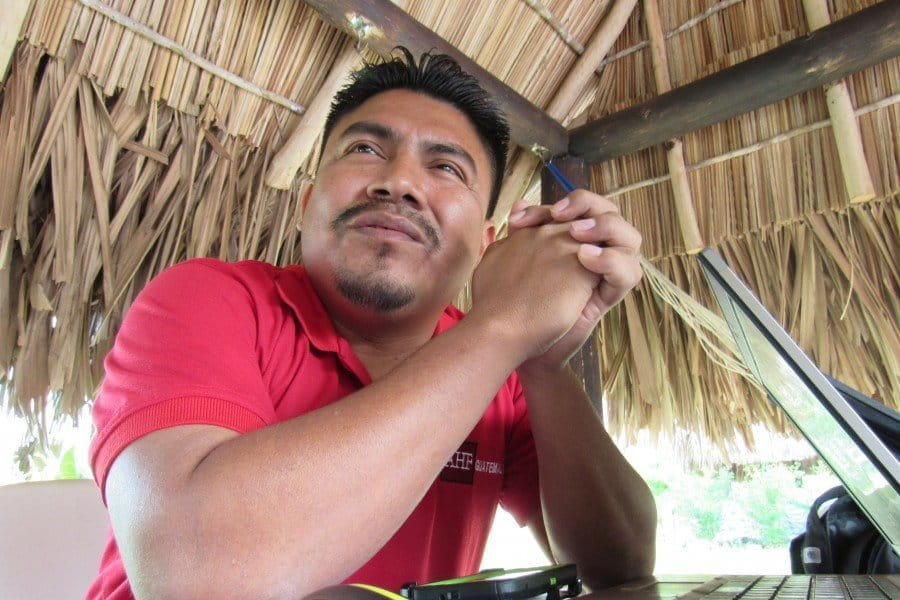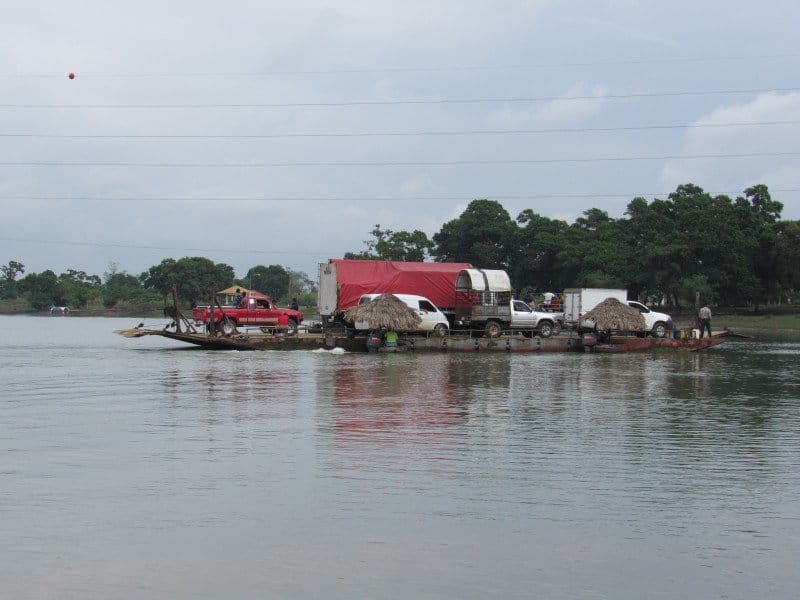- There is no general consensus on what to do about the cause of the ecological disaster: REPSA (Reforestadora de Palma de Petén S. A.), an African palm oil plant.
- According to the fishermen, in the past eight months La Pasión River has lost its crabs and “piguas” (Macrobrachium carcinus), a large shrimp species.
- Activists hope that a trial against REPSA will start this month –something that could be bring about more conflict to the area.

Nine months ago, the water of La Pasión River showed up smelling foul and covered with dead and poisoned fish. Soon after, hundreds of fishermen of Sayaxché —the largest nearby river community– learned two new terms coined by environmentalists and by the Guatemalan government: “ecocide” and “closed season.”
Many of those fishermen are now deep in debt and embroiled in conflict. There isn’t even a general consensus over what to do about the cause of the ecological disaster: REPSA (Reforestadora de Palma de Petén S. A.), an African palm oil plant located about 74 miles upriver. The company provides the main ingredient for cooking oils Olmeca and Ideal as well as for Frito Lay and Bimbo.
In Sayaxché there is a neighborhood simply known as “The Fisherman”, that now appears dark and depressed. It recently closed the last storefront business that sold fishing supplies. On June 2015, the government unofficially banned fishing in the area after finding out that the river had very high levels of an agricultural insecticide called Malathion. However, a few months later, none of the supervisors in charge of controlling the fishing activity were still working at the site.
No one knows if the closed season is still in place, or if that substance that is said to have killed around 40 tons of fish of 23 different species –which also had an impact on the health of many of the fishermen– ended up dissolving into the river. Many people are back to fishing. In Sayaxché’s market, some saleswomen have gone back to advertising “pejelagartos” and “sardinas de leche” from La Pasión River, for about two dollars a pound. Before the ecocide, the fishermen of Sayaxché say they used to sell about 400 pounds a day. Back then, the fish were much bigger and there were great quantities available.

María Córdoba, a representative of one of the fishermen’s families in Sayaxché, is sure that the impacts of the poisoning are still being felt: in her case, it is her $1,500 debt to a local bank. This may not be that much money to other people, but she hasn’t been able to pay any of it off in the past eight months. Besides, the has to feed her three children –a 14 year-old, a nine year-old and a two year-old– often, with fish from the river.
“Fewer people want to buy the fish. They think the water is still contaminated, even though I think it’s back to normal.” Córdoba adds that there is something else that is making things worse: the communities that live upriver don’t want their families –nor fishermen from Sayaxché— to keep fishing.
REPSA did not recognize the ecocide, but it handed out 201 big water bottles, it paved some streets; built a pool, and some wells. In a strange turn of events, the governor of Petén, Manuel Barquín, said that those responsible for the disaster could have been drug traffickers who may have used the chemicals for their narco labs. Barquín was later accused of owning REPSA stocks, and currently he’s on trial for illicit associations and money laundering.
Contrary to what most people would expect, Evaristo Carmenate does not call for the indefinite closure of REPSA. He’s thinking about jobs: “In this region, more than 4,000 families depend directly on REPSA. If they closed it, those families would be left without jobs or land –they’ve already sold their land to them. This would unleash vandalism and invasions to the nearby rainforest and to archaeological sites. The social disaster it would bring forth would be even worse.”
Carmenate blames Guatemala’s government instead, and is asking REPSA to build more rusting pools, and to return to the river what it took.

According to him and other fishermen, in the last eight months, La Pasión River has lost its crabs and “piguas” (Macrobrachium carcinus), a large shrimp species. Besides, many biologists lament the possibility that the ecocide may have included the extermination of 23 fish species, including many “xixi” (Thorichthys pasionis), a beautiful yellow and blue fish that had been close to extinction for some years.
“It’s very sad, those were probably the last xixis we will ever see again,” said fish farmer Manuel Ixquia, from the Center of Sea Studies of Guatemala (Centro de Estudios del Mar de Guatemala), who confirmed that the only species who were able to escape the poisoning were turtles and crocodiles.
Faced with what the United Nations called an “ecological disaster”, the scientific community in Guatemala published a statement incriminating REPSA and asking the government to step in. They concluded that the cause had been a mortal blend of Malathion and waste water from palm oil processing —a liquid that is 100 times more poisonous than sewage. This caused “a high biochemical demand for oxygen” that asphyxiated adult fish up to two feet long; this fact could compromise future fish populations in years to come.
REPSA’s palm oil plantations occupy more than 96 square miles of Petén, the biggest, flattest and northernmost region of Guatemala. A century ago, this region was completely covered with rainforest vegetation.
Today, Sayaxché is a town of about 48,000 people surrounded by some oil extraction towers, subsistence crops, and a lot of African palm oil. According to Oil World magazine, Guatemala is the Latin American country with the fastest growth in African palm oil production; a growth of 11 percent since last year. In the country, palm oil cultivation often means forced labor, child labor, health impacts, and environmental damage, according to a statement put out a year before the environmental disaster by Verité, a global labor rights organization.

Saúl Paau, another community leader in Sayaxché, is asking REPSA to close down opearations in the area.
“My fight isn’t for money, but for justice. The fishermen can’t ask to be paid for the damage because they don’t own the river. They have to follow the closed season, they have to follow the law. They weren’t the only ones impacted –so was the environment, and the food security of thousands more people,” says Paau.
Paau hopes that this month REPSA will be taken to court –something that threatens to cause even more conflict in the area. Last September, a judge in Petén ordered the “partial” closure of REPSA; a day later, Rigoberto Lima Choc was gunned down in Sayaxché’s town center. He was a local teacher whom many believe was the first to accuse REPSA of the ecocide. His assassination is something people can’t seem to agree on. The company hasn’t said anything about the crime, nor about the kidnapping of three community leaders at the hands of REPSA employees.
Meanwhile, inside Ricardo Martínez Tobar’s home, people can be heard sobbing. His family owes $23,000 to a local bank, so he’s sold a boat motor, a large cooler for fish and his own home for $53,000 to try to pay it back. To make things worse, a little more than a month ago, his pick-up truck was stolen. Now he says everyone’s going hungry.
Without a pick-up, with his loan interests going up, and his kids’ mouths to feed, Martínez Tobar says he doesn’t know what else to do: “Without work I don’t know how to defend myself. I am 55 years old and I’ve been a fisherman for 36; I only know how to fish. The poison that fell on the river nine months ago continues to harm us: we’re all turning against each other and the fish is gone. But what’s worse, we’ve lost our dignity.”

